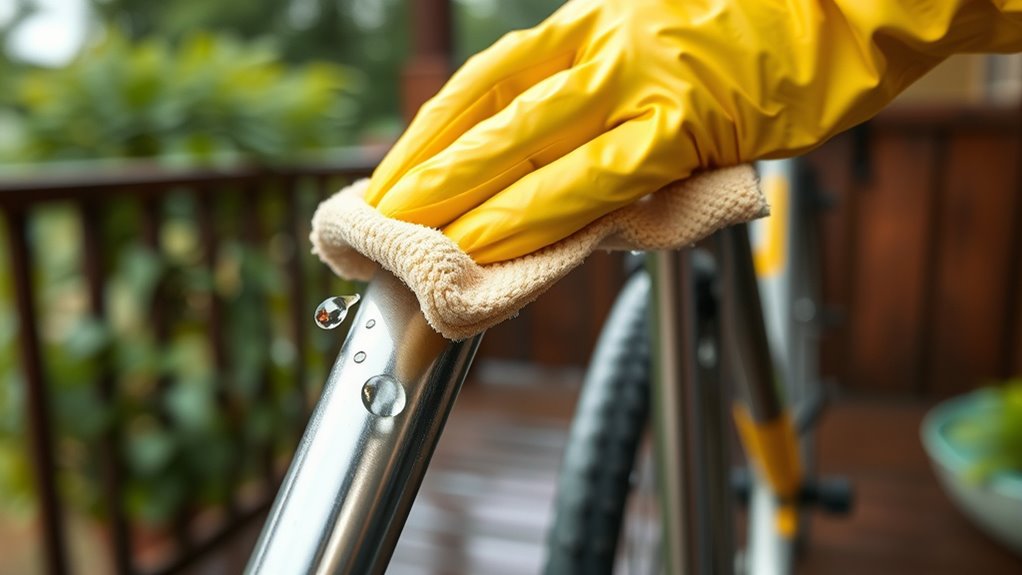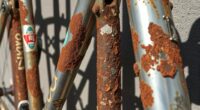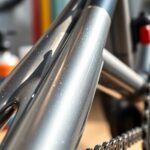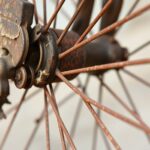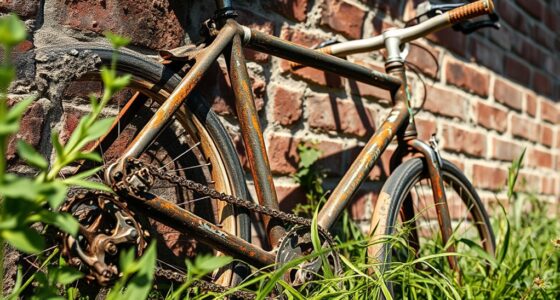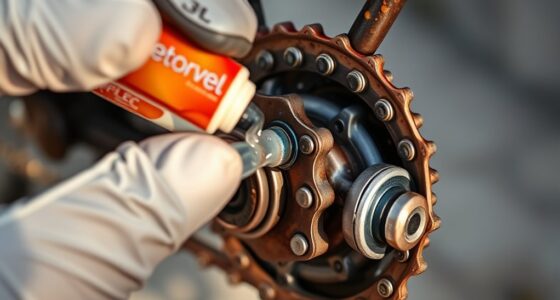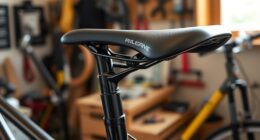After heavy rain, quickly inspect your outdoor items for moisture, chips, or cracks. Reapply waterproof coating or rust inhibitors to keep moisture out. Clean dirt and mud from surfaces, then dry everything thoroughly. Store equipment in dry, ventilated spaces, elevating items to prevent puddles. Regularly check for damage and touch up protective coatings as needed. Consistent maintenance helps prevent rust buildup—learn more tips to keep your gear in top condition.
Key Takeaways
- Inspect outdoor items for damage and reapply waterproof coatings immediately after rain.
- Clean surfaces thoroughly to remove dirt and debris, then dry completely to prevent moisture buildup.
- Apply rust inhibitors and multiple coats of protective paint on exposed or worn areas for enhanced protection.
- Store equipment in dry, well-ventilated spaces, elevating items off the ground to avoid puddle contact.
- Regularly inspect, maintain, and recoat outdoor tools and furniture to prevent rust accumulation over time.

After a heavy rain, metal surfaces and outdoor equipment are vulnerable to rust if not properly cared for. Water seeps into tiny crevices and settles on surfaces, creating the perfect environment for corrosion to begin. To prevent this, you should act quickly and use effective rust inhibitors to shield your belongings. Applying waterproof coatings is one of the best ways to create a barrier that repels moisture and protects against rust formation. These coatings are specially formulated to withstand harsh weather conditions and keep metal surfaces dry, even during heavy downpours. When you notice that your outdoor items have dried, inspect them carefully for any signs of moisture or damage. Reapplying waterproof coatings regularly ensures continuous protection, especially if your equipment is exposed to frequent rain.
Protect outdoor metal surfaces from rust with waterproof coatings and regular inspections.
Next, take a moment to clean your outdoor gear. Dirt, mud, and debris can trap moisture against the surface of metal objects, accelerating rust development. Use a brush or cloth to remove any grime, then rinse with water and dry thoroughly. This step is vital because residual dirt can compromise the effectiveness of rust inhibitors and waterproof coatings. Once completely dry, apply rust inhibitors to vulnerable areas. These products chemically bond to the metal surface, creating an invisible shield that prevents rust from forming. Make sure to follow the manufacturer’s instructions for application, as proper coverage is essential for maximum protection. For added security, consider using multiple coats, especially on heavily exposed or older equipment.
After applying protective coatings and inhibitors, inspect your tools and outdoor furniture regularly, especially after storms. Look for any chips, cracks, or areas where the coating might have worn away. Touch up these spots promptly to maintain a continuous barrier against moisture. If you store your equipment in an outdoor shed or garage, ensure that the space is well-ventilated and dry. Moisture can linger in enclosed spaces, so consider using silica gel packs or dehumidifiers to reduce humidity levels. Elevating your outdoor furniture and tools off the ground can also prevent prolonged contact with puddles or standing water, further reducing rust risk.
Finally, establish a routine to maintain your outdoor equipment. After heavy rain, take a few minutes to clean, dry, and reapply waterproof coatings if needed. Regular upkeep not only prolongs the lifespan of your belongings but also saves you money in the long run by avoiding costly rust repairs. Properly storing your items in a dry environment can significantly decrease the chance of rust formation. By staying proactive with rust inhibitors and protective coatings, you’ll keep your outdoor equipment in great shape, even after the heaviest storms.
Frequently Asked Questions
How Long Should I Wait After Rain to Clean My Equipment?
You should wait at least 30 minutes to an hour after rain before cleaning your equipment. Timing considerations are vital because cleaning too soon might push moisture further into sensitive areas, increasing rust risk, while waiting too long allows water to dry naturally. Remember, equipment sensitivity varies; some materials need more careful handling. Always dry thoroughly afterward and apply protective oil to prevent rust formation.
Can Drying Methods Damage Sensitive Surfaces?
Like a careful artist, you must choose drying techniques that respect surface sensitivity. Some methods, such as high-pressure air or rough towels, can damage delicate surfaces. Instead, opt for gentle air drying or soft cloths, ensuring you don’t cause scratches or warping. Always consider the material’s resilience, much like tending a fragile bloom—patience and proper drying techniques keep your equipment in pristine condition and prevent rust.
Is It Necessary to Apply Protective Coatings Regularly?
Yes, you should apply protective coatings regularly to keep rust at bay. A consistent maintenance schedule guarantees your surfaces stay protected from moisture and corrosion. By reapplying protective coatings when needed, you prevent rust from forming and preserve the integrity of your equipment or structure. Make it a habit to inspect and maintain these coatings, especially after rain, to extend the lifespan and keep everything in ideal condition.
What Are the Best Storage Conditions to Prevent Rust?
Imagine your tools nestled in a cozy, dry cabin. To prevent rust, you should store them in a cool, dry environment where moisture control is prioritized. Use silica gel packs or dehumidifiers to keep humidity low. Applying corrosion inhibitors adds an invisible shield, like a guardian angel, protecting your tools from moisture and rust. Keep storage well-ventilated and away from water sources for the best results.
Does Climate Affect the Frequency of Post-Rain Maintenance?
Yes, climate impact definitely influences how often you need post-rain maintenance. In humid or coastal areas, you’ll find rust forms faster, so you should clean and dry your equipment more frequently after rain. Conversely, in dry climates, maintenance frequency can be lower. Pay attention to local weather patterns, and adapt your routine accordingly to prevent rust effectively, ensuring your tools stay in good shape longer.
Conclusion
By drying your bike, inspecting for damage, and applying protective coatings, you safeguard your ride from rust. By staying vigilant, maintaining consistency, and caring for your equipment, you guarantee its longevity. By taking these simple steps, you preserve your investment, enhance your safety, and enjoy your rides without worry. Keep up this routine, and your bike will thank you with years of reliable service. Stay proactive, stay protected, and keep riding rust-free.
